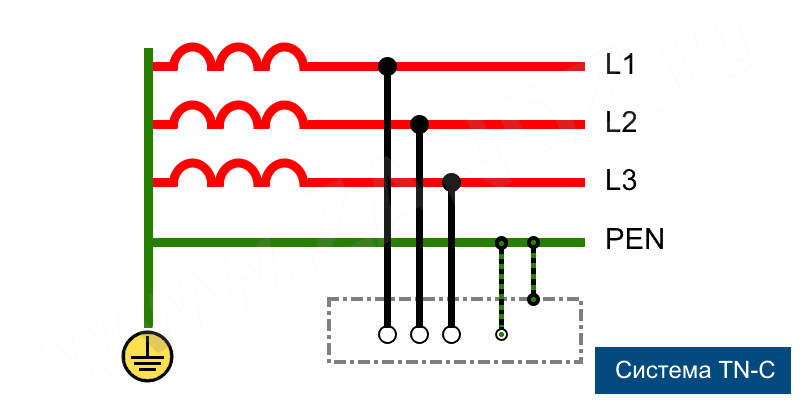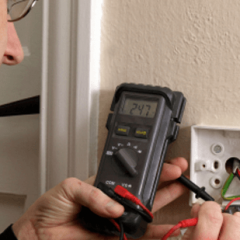What are the grounding systems?
TN and its varieties
The most common type of grounding system is TN, in which zero is aligned with the ground along its entire length. This type is also called dead-grounded neutral in supply, when the conditional source N is connected to the PE grounding device. The grounding device is not difficult, but nonetheless technologically advanced and represents a group of pins driven vertically into the ground to a considerable depth to the aquifer, from 2.5 meters or more. These pins are connected by a strip or cable into a single ground loop of a residential building. Consider what classification of TN systems exists today and what is the difference between all varieties.
TN-C
Old housing uses protection type TN-C, this is when the working neutral conductor N also acts as a protective conductor PE. This is the easiest and cheapest option for grounding electrical installations up to 1000 V.
Type TN-C is obsolete and electrically dangerous, since it does not have a separate protective conductor, and in the case of zero wire break, during an emergency, the full potential will be on electrical equipment, exposing a risk of electric shock or fire.
TN-S
Therefore, in the newly designed buildings, another subsystem is used. TN-S, in this device there is a separate phase wire, zero (neutral) and protective conductor PE.Conductors N and PE, starting from a substation with a grounded neutral, are separate components of the power supply system.
This type is the most reliable of the accepted types of grounding of the electrical network. Its disadvantages include high cost, as it needs an additional conductor from the substation to the consumer.
TN-C-S
Free from these shortcomings, relatively easy to implement TN-C-S system, which combines the advantages of the previously described systems. Also easily implemented during the reconstruction of old buildings. The meaning of this scheme is that the TN-C system is organized before the main switchboard, here the neutral PEN wire is divided into two conductors N and PE, then the TN-S system.
The disadvantage of this system is the same as the TN-C, when the PEN bus breaks, the system is under full voltage. They are struggling with this by installing additional devices, such as voltage relayproducing emergency disconnection of the consumer from the network.
TT and IT
There are two more types of supply that are used in special conditions, this type TT - when the delivery of electric energy is organized by phase wires from a source with a grounded neutral, and grounding is organized directly at the consumer. In this way, connect mobile homes, temporary objects.This type requires the use of residual current devices RCD.
Another option is IT system, type of supply not using dead earthed neutral. The source zero is connected through special devices having high internal resistance, and a zero and protective grounding device is installed directly at the consumer (according to PUE 7, chapter 1.7) This type of supply is used in special laboratories, since the interference introduced in this way is minimal.
We also recommend that you watch a video that provides a description of each type of grounding system with an interpretation of the abbreviations:
And finally, we want to pay attention - it is forbidden to use heating pipes, gas pipes, water pipes, elements of metal fences as protective grounding. In this case, the appearance of a full voltage of 220 volts on these elements is possible, endangering the life of others. Take care of yourself.
That's all I wanted to tell you about the main types of grounding systems. We hope that now you know what kind of grounding circuits there are and what are the differences between the existing options!
It will be interesting to read:











